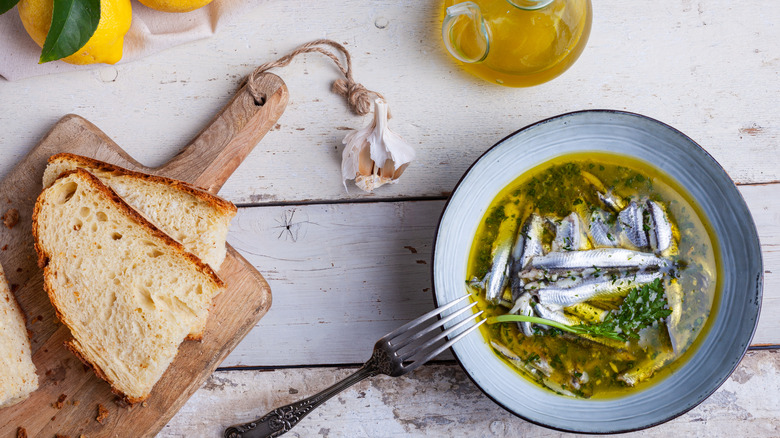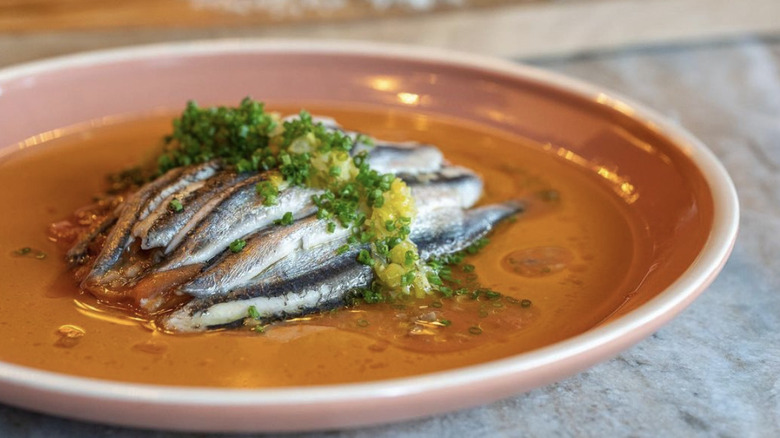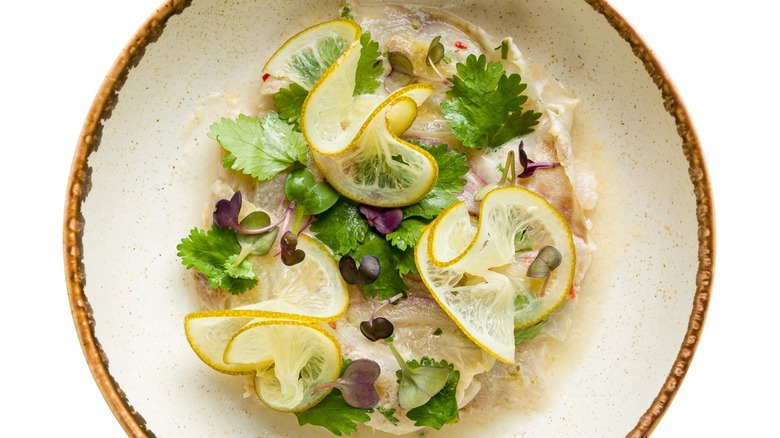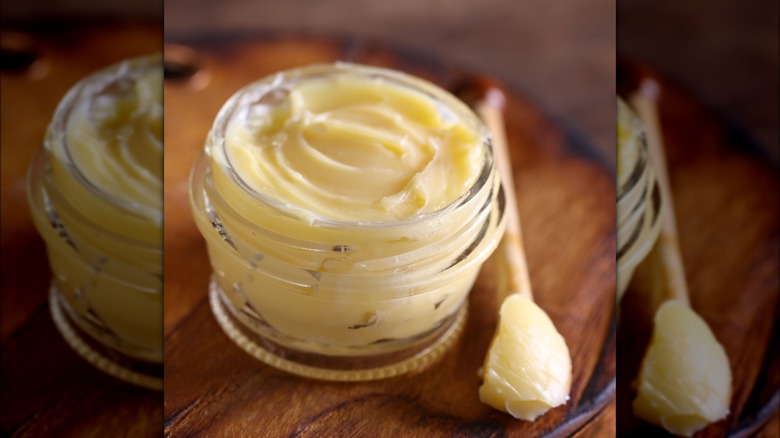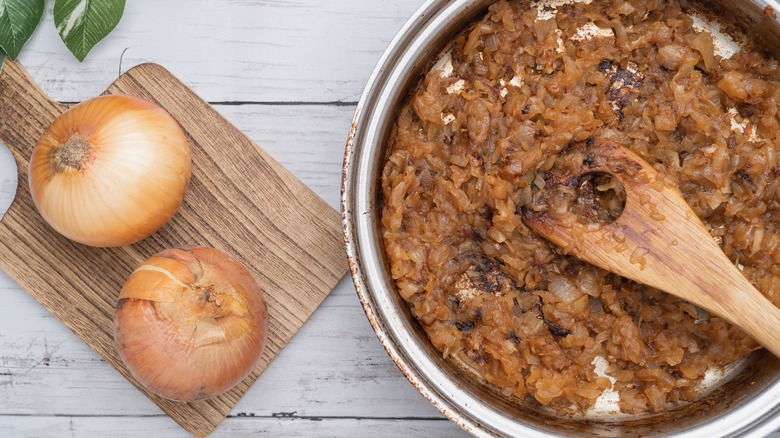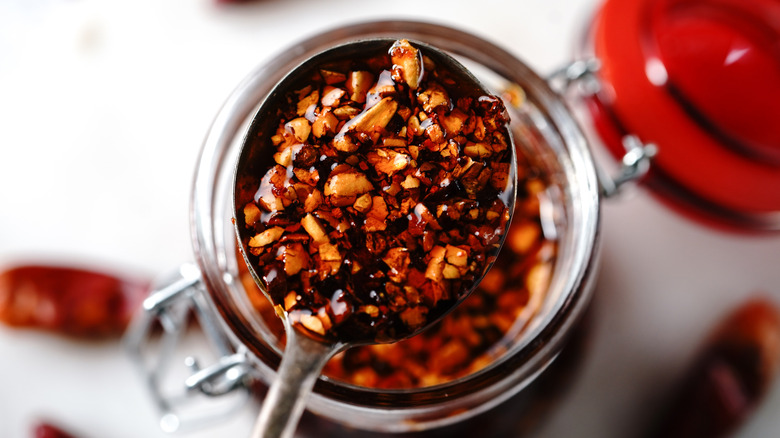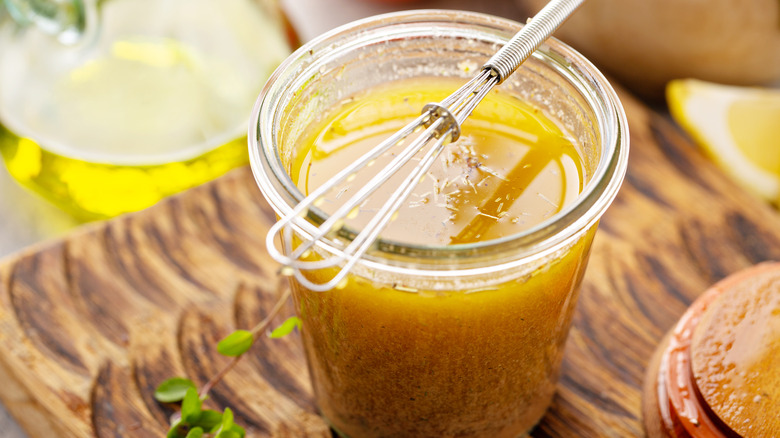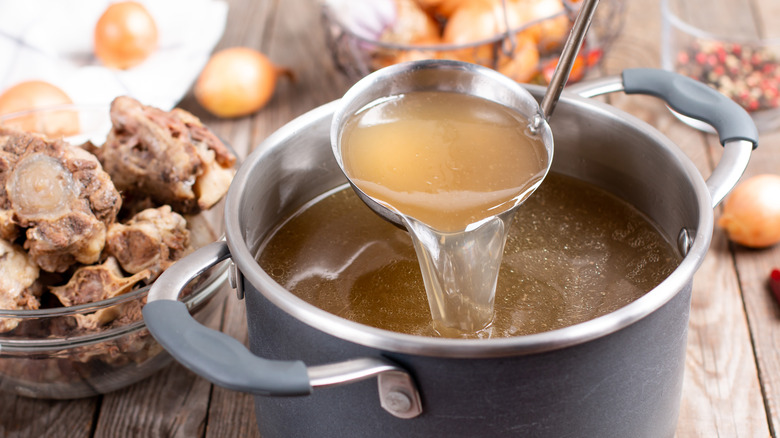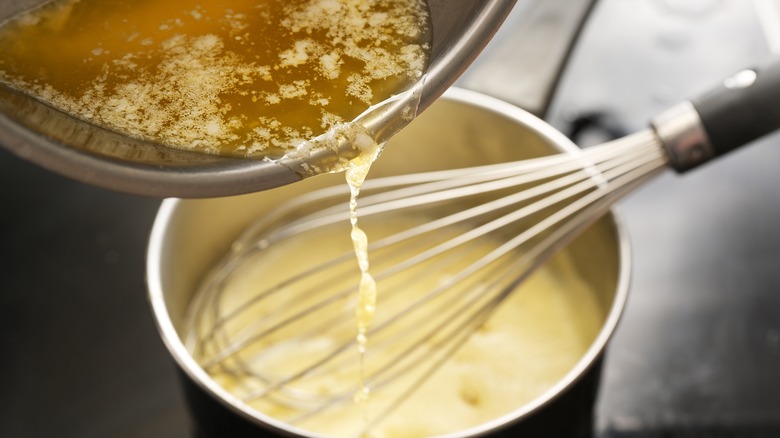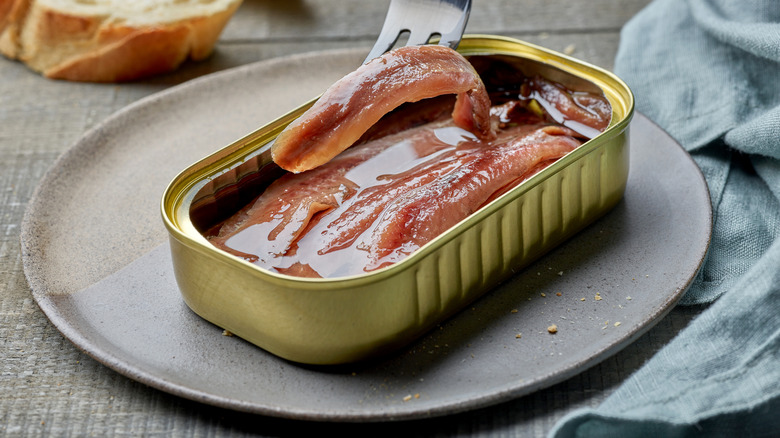8 Creative Ways To Use Anchovy Oil, According To An Expert
By now you're probably well-acquainted with the virtues and versatility of anchovies, the oily fish you should start putting in more of your recipes. From bean soups and olive-oil-dressed pasta to hearty bitter greens salads, a few fillets of anchovy tossed in for good measure give unexpected depth and richness to many savory dishes.
While some anchovies are packed exclusively in salt, many are packed in oil, leaving anchovy lovers to scratch their heads about what they should do with all that excess. Not only can pouring the leftover oil down the drain clog your pipes, but you'd also be throwing fat rich with anchovy flavor down the proverbial drain.
Fortunately for us home cooks, this problem plagues restaurants, too. To learn how to deal like a seasoned chef, we consulted Marcos Campos, Group Executive Chef and Partner of the Chicago-based Bonhomme Hospitality group known for building design-forward Spanish "concepts" (not restaurants), like the exotic Beatnik, chic Mama Delia, and Michelin-starred, conservas-centric Porto.
In addition to useful tips on how to work with anchovy oil in the kitchen, the Spanish-born Campos wasn't coy about his taste for high-quality Spanish conservas, plus the qualities to consider when sourcing anchovies for our pantries. Read on to learn how you can fortify several basic recipes (that you're likely already making from scratch) with the potency and potential of anchovy.
What to look for when buying anchovies
To know a delicious anchovy when you eat one, you must start at the level of the fishery. Campos notes that he prioritizes traceability when selecting the anchovies for his restaurants, preferring to source from companies that "handle the freshest, highest-quality fish available in the market." Doing a little research on a brand's commitment to sustainable fishing practices before purchasing a tin (or jar) for yourself will point you in the right direction.
The most accessible anchovies for purchase are, unsurprisingly, those packed in oil. Oil-packed anchovies are still brined in salt (for up to two months) before they're processed and packed under fat. While salt-packed are still commercially available — and extraordinarily delicious because of salt's ability to concentrate flavor and firm up texture — they're usually pricier and found online.
Consider also the type of fat in which anchovies are preserved, as this will impact the taste of the anchovies and the oil. Most brands will list this on the packaging. For flavor and versatility, extra-virgin olive oil is preferable. Stick with olive oil-packed anchovies for executing Campos' suggestions below. As for texture, "meaty" is the unequivocal ideal. "We specifically seek out larger and thicker anchovies for their superior saltiness balance," says Campos. He notes that smaller anchovies tend to be saltier. "Moreover, the larger size typically indicates a higher fat content, contributing to the rich umami flavor we desire for our dishes."
1. Use anchovy oil to season ceviche
When considering how best to utilize this beautiful, but bereft by-product, the most intuitive place to start is with dishes that are naturally seafood-based. Campos is partial to sneaking it into ceviche: Just as salt enhances flavor, anchovy oil — with its built-in umami notes and subtle saltiness — does the same for raw seafood.
Anchovy oil also ties the flavors of an otherwise lean dish together. Yes, we know the most important ingredient in ceviche is citrus juice, which "cooks" the fish by firming up the proteins. But many ceviche recipes also include some kind of fat — whether avocado, olive, or grapeseed oil — to meld the flavors and give a bracingly sour seafood salad a smooth mouthfeel. Since ceviche is best made with lean fish whose lower fat content will yield a firmer, more opaque bite, adding additional fat to the dish is crucial.
Using anchovy oil instead of more neutral-tasting oils has an added benefit. "Adding [anchovy oil] as a seasoning into our ceviches enhances the sea flavor with the natural sea salt used in the curing process," says Campos. Remember, since anchovy oil contains small amounts of salt, you'll want to be mindful of additional seasoning. Salt also dehydrates food, including raw fish, which will affect the texture of your final dish as it sits. For best results, season ceviche with salt and oil shortly before serving.
2. Whip anchovy oil into cultured butter
Since the flavor of anchovy carries easily, Campos is partial to this umami-rich fat when seasoning cultured butter. Unlike sweet cream, cultured butter is made by beating cream that's been fermented instead of pasteurized until it separates into buttermilk and butter. Fermenting the cream gives the butter a tangier flavor that offsets the richness and balances the saltiness inherent in anchovy, making it the perfect complement to anchovy oil.
Stabilizing the anchovy oil in butter before serving gives Campos' menu versatility. "We use anchovy butter for various applications, from our bread service to finishing a steamed mussels dish, to emulsifying the wine sauce," Campos says. Anchovy butter can also be used to fortify seafood-based dishes and sauces through a technique called "mounting," where sauces are finished with a knob of cold butter for a velvety texture. To make an anchovy compound butter, drizzle the oil in slowly when whipping the butter to avoid breaking the emulsion.
In addition to sauces, umami-rich cultured anchovy butter is an unlikely, yet optimal partner in crime when searing steak. Why? Culturing butter gives it a higher smoke point, which is ideal when aiming for a crust while searing proteins at high temperatures. Anchovy cultured butter would be especially delicious with grass-fed meats, whose gaminess is only enhanced alongside an equally umami-rich ingredient.
3. Cook down onions in anchovy oil
We assumed the only ingredient that could enhance a simple caramelized onion recipe was patience. According to Campos, who adds anchovy oil to his "glazed onions," we were wrong. "We discovered that the balance between sweet onion and the lightly salty, umami flavor of anchovy oil is the perfect garnish for wood-fired grilled steak," says Campos. While letting onions do their thing on the stovetop without scorching is key to caramel color, cooking them in anchovy oil adds a layer of flavor without sacrificing a fillet.
Though he mentions glazing — a technique for coating an ingredient in a syrupy pan sauce — we're interpreting this as the more common (and versatile) caramelizing. Caramelized onions start with two basic ingredients: Fat and freshly sliced sweet onion. Instead of the butter, olive oil, or neutral oil common to most recipes, replace the fat with anchovy oil to get a pop of umami flavor — similar to adding part of a fillet to the dish during cooking.
In the Provençal onion tart pissaladière, the French have illustrated how harmoniously sweet onion and salty anchovy work together. In keeping with this theme, Campos suggests using onion cooked with anchovy oil as a topping for bistro-inspired steak. Try folding anchovy-infused caramelized onions into a custard for quiche, using them to fill an omelet or crepe, or adding them into the sautéing step of an easy French onion soup recipe.
4. Use anchovy oil when brining fish
You may be most familiar with brining poultry since it's mild in flavor and prone to overcooking, but brining (both wet and dry) works just as well for fish. "In brines for our fish, we incorporate fish oil to aid in the seasoning process throughout the fish," Campos says. He suggests pouring the anchovy directly on the flesh of the fish or into a marinade. Like adding salt to pasta cooking water, this additional seasoning penetrates the flesh of the fish, amplifying flavor before pan sauces, compound butter, and other toppings get there first. Aside from seasoning fish, brining reduces the excretion of albumin, the white, oozing protein that escapes salmon during cooking.
To make a wet brine, whisk salt, water, and anchovy oil together until dissolved. Submerge the fish in the solution and refrigerate. When you're ready to cook, give the fish a quick rinse. The reaction between the salt and water tenderizes the fish, producing a succulent and juicy bite that withstands greater variance in cooking time than un-brined fish.
Alternatively, for a quick marinade, rub the anchovy oil directly into the flesh of your fish. This mimics the process of dry brining — when salt is sprinkled onto the fish and left to sit. The small amount of salt left in the oil may produce a similar, if not more subtle effect on the fish than wet brining.
5. Fortify jarred or homemade XO sauce
If you haven't tasted XO sauce, the luxurious umami-packed Chinese condiment originating in 1980s Hong Kong, a tin of leftover anchovy oil on hand is your invitation to make a batch yourself. "In our XO sauce recipe, we use anchovy oil for the umami, light saltiness, and fish flavor," says Campos. XO sauce is made from salted, cured seafood like scallops (or "conpoy" in Cantonese) and shrimp. In Cantonese cuisine, XO sauce is considered a high-end item due to the abundance of dried, premium seafood it contains.
Other less-expensive, but no less flavorful ingredients include aromatics like chili, garlic, and shallots. Like the highly popularized chili crisp condiment, for texture, these aromatics are fried until crispy in neutral oil before being stirred into the sauce. The sauce is also fortified with brown sugar, soy sauce, and other flavorful condiments, then simmered until thick. If experimenting with homemade XO sauce, this is the perfect opportunity to utilize lower-quality anchovy oil (instead of neutral or olive oil) as a frying substitute.
XO sauce can be used as a dipping sauce for appetizers like dim sum and dumplings, mixed into stir-fries, or added to Asian noodle and grain-based dishes like chow mein and congee. Though the resulting condiment will hardly taste like anchovy given the abundance of other bold, funky ingredients, you at least avoid tossing an otherwise perfectly suitable oil in the bin.
6. Whisk up an anchovy-spiked vinaigrette
Perhaps the most obvious application for anchovy oil is as a substitute for olive oil in a Caesar dressing — the gateway dish for learning to love anchovies. But using this already-infused oil in any salad dressing recipe, like a simple French vinaigrette, gives the dressing a depth that makes Caesar salad so craveable.
"Creating an anchovy vinaigrette involves mixing equal parts extra virgin olive oil and anchovy oil," says Campos. Of course, you'll need something acidic to round out all that fat, and we suggest lemon juice, or even sherry vinegar — whose Spanish origins feel right at home with Campos' suggestion. And although Campos didn't suggest adding minced anchovy, if you have a fillet lingering in your tin it would be most welcome for visual effect, flavor, and a bit of texture. To add body and further depth to your dressing, whisk in a bit of Dijon mustard, too.
By now you already know that the flavor of anchovy, though strong, is surprisingly versatile. A vinaigrette infused with this salty, savory fish doesn't need to be limited to applications where you'd traditionally expect fish flavors. Campos suggests seasoning ripe summer heirloom tomatoes, which he believes results "in one of the best bites you can experience." With its funk and depth, an anchovy-based vinaigrette amplifies even the most straightforward ingredients.
7. Add richness to soups and stocks
Anchovies are powerfully savory. Their potency makes for a fitting addition to stock, whose primary purpose is to provide a base of umami flavor in place of water. "We use anchovy oil to finish seasoning some of our stocks instead of using salt," Campos says. "Seasoning" refers to any ingredient added to a dish to intensify its natural flavor: Think salt, acids like lemon juice and vinegar, and even olive oil. Harnessing the skill of proper seasoning is, after all, the trademark of a strong cook.
The proper technique for homemade stock is to skim the excess fat that rises to the surface. This is especially beneficial if you plan on storing your stock for use in various applications, so save adding additional oil until the end, when the umami characteristics present in anchovy oil will work best to improve the flavor of your finished dish.
We've covered how you can ditch bouillon cubes and let anchovy paste flavor your stock. Anchovy oil works similarly, albeit more subtly. Unlike bouillon cubes, which pack a savory punch with ingredients like salt and MSG, anchovies contain naturally occurring glutamate, the compound that gives umami-rich foods like tomatoes and cheeses their savory quality. Fortifying your stocks and soups with anchovy oil adds another degree of flavor without the use of additives found in bouillon cubes.
8. Enrich hollaindaise sauce
Hollandaise, one of the five French mother sauces, is a buttery emulsion lightly seasoned with lemon. Though versatile, hollandaise sauce made with only butter, lemon, and egg yolk is mild-tasting at best. To add depth, Campos likes to fortify his with "a small touch of anchovy oil, resulting in an incredibly creamy, buttery texture with a delightful anchovy flavor." Depending on the amount of butter vs. oil used, the flavor of your sauce can range from subtly umami to outwardly fishy, so keep that in mind when considering which foods to pair with it. Though anchovy oil hollandaise may complicate the bacon flavor of a classic egg benny, steamed vegetables and a perfectly seared steak benefit from the lift.
Emulsification occurs when two substances whose molecules would otherwise resist one another — like oil and water — are combined through vigorous agitation. The technique for making hollandaise is largely the same as mayonnaise: Fat is slowly whisked into egg yolks until thick and emulsified, then seasoned with lemon juice to loosen it and salt to up the flavor. You could even go so far as describing hollandaise as a warm mayonnaise. Because of the similarities in technique, hollandaise can be made with a small amount of oil for additional flavor without breaking the emulsion. Just make sure to whisk in your anchovy oil toward the end, when the hollandaise is thick, creamy, and stable.
A chef's favorite gourmet anchovy brands
An inexpensive tin of anchovies will work just fine in most recipes. But we couldn't help but pick Campos' brain about the high-end brands he prefers to serve at his restaurants. "As a Spaniard, I adore anchovies from Santander, a region of Spain renowned for its anchovy culture in the north," Campos says. He tells us that each of these brands is distinguished by its exceptional quality.
Don Bocarte, a brand of Cantabrian anchovies (around $50 per 200-gram tin) is a favorite of Campos'. The fish are caught near Santoña, in the Bay of Biscay, during peak season between April and June. They're then preserved for at least eight months under rigorous temperature and humidity standards. "They're delicate, creamy, and melt-in-your-mouth," says Campos.
Bahia de La Concha (around $70 per 500-gram tin) is another brand of exclusively Cantabrian anchovies preserved in extra virgin olive oil. "They boast a light saltiness and an 'al dente' texture," says Campos. He points out that the fish are salt-cured for just the right amount of time, making them the perfect anchovy to enjoy straight from the tin.
For something different, Campos recommends Spanish conservas proprietor Doña Tomasa's coastal anchovies with butter (approximately $26 per 115-gram tin). These, Campos says, are the "perfect combination of the intense flavor of anchovies and the softness of butter." The butter is made with milk from Pasiega cows, an endangered breed of dairy cattle native to Cantabria.
